
Schinia, commonly called flower moths, is a large genus of moths belonging to the family Noctuidae. The genus has a Holarctic distribution with the vast majority of species being found in North America, many with a very restricted range and larval food plant.

Autographa is a genus of moths of the family Noctuidae.

Autographa californica, the alfalfa looper, is a moth of the family Noctuidae. The species was first described by Adolph Speyer in 1875. It is found in western North America from southern British Columbia to Baja California and to Manitoba, South Dakota, Colorado and New Mexico.
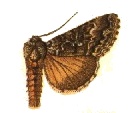
Syngrapha alias, the hooked silver Y, is a moth of the family Noctuidae. The species was first described by Rodrigues Ottolengui in 1902. It is found in North America from Newfoundland to Alaska and Vancouver Island, north to near the treeline and south in the west to coastal north California and Arizona, in the east to North Carolina.

Anicla exuberans is a moth of the family Noctuidae first described by John Bernhardt Smith in 1898. It is found in North America from central Mexico north to the dry interior of southern British Columbia, southern Alberta and south-western Saskatchewan.

Brachionycha borealis is a moth of the family Noctuidae first described by Smith in 1899. It is found in North America from Maine and Pennsylvania west to central Alberta.

Autographa ampla, the large looper moth, raspberry looper, brown-patched looper or broken-banded Y, is a moth of the family Noctuidae. The species was first described by Francis Walker in 1858. It is found in North America from Newfoundland west to the Alaska panhandle, south to central California, Arizona and New Mexico in the west and North Carolina in the east.
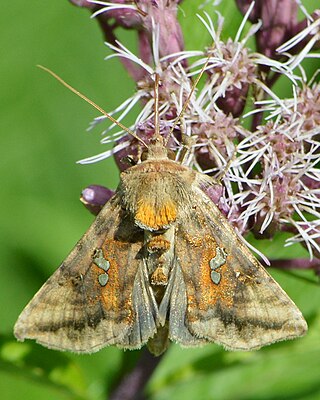
Autographa bimaculata, the two-spotted looper moth, twin gold spot or double-spotted spangle, is a moth of the family Noctuidae. The species was first described by James Francis Stephens in 1830. It is found in North America from Newfoundland west, just short of the coast of British Columbia, north to the Northwest Territories and south to New Mexico in the west and Pennsylvania and Long Island in the east.
Autographa flagellum, the silver whip, is a moth of the family Noctuidae. The species was first described by Francis Walker in 1858. It is found in North America from Newfoundland west across southern Canada to south-eastern British Columbia, south in the east to Maine, Michigan and Wisconsin. There are isolated reports from further south.
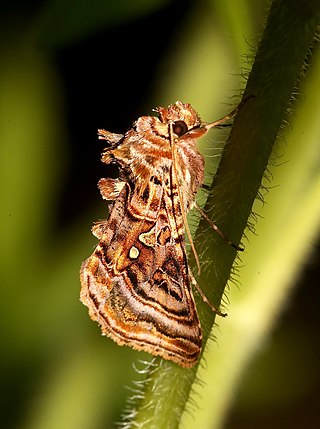
Autographa mappa, the wavy chestnut Y, is a moth of the family Noctuidae. The species was first described by Augustus Radcliffe Grote and Coleman Townsend Robinson in 1868. It is found in North America from Newfoundland west across the wooded portions of Canada to Vancouver Island, south in the east to Maine, New Hampshire and Wisconsin, and in the western mountains south to Colorado and Oregon.
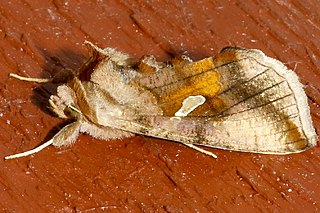
Autographa metallica, the shaded gold spot, is a moth of the family Noctuidae. The species was first described by Augustus Radcliffe Grote in 1875. It is found in western North America from the southern Alaska coast and the Queen Charlotte and Vancouver Islands south to central California, east to the Alberta-British Columbia border and south in the Rocky Mountains to central Colorado.
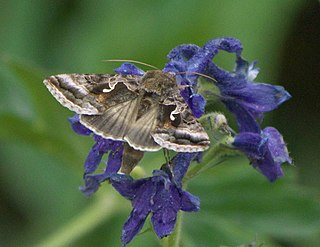
Autographa pseudogamma, the delicate silver Y, is a moth of the family Noctuidae. The species was first described by Augustus Radcliffe Grote in 1875. It is found in North America from Newfoundland to coastal northern Alaska, south in the east to New England and in the western mountains to New Mexico, Arizona and California. It is also found in the Cypress Hills and the Black Hills of South Dakota.
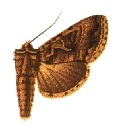
Autographa rubida is a moth of the family Noctuidae first described by Rodrigues Ottolengui in 1902. It is found from Newfoundland west across southern Canada to south-eastern British Columbia, south to Maine, and Minnesota.

Autographa sansoni, the Alberta beauty, is a moth of the family Noctuidae. The species was first described by F. H. Wolley Dod in 1910. It is found in the western mountains of North America, from Alaska south to Oregon, Idaho and Arizona. Occurring mainly in the Pacific Northwest, it thrives in mid-to-high elevation conifer forest habitat, as well as some areas of coastal rain forest in the Coast range. However, it is also found in a non-contiguous range in sub-alpine forest in the Rocky Mountains, ranging from Alberta in the north, to New Mexico in the south. The wingspan of an adult ranges between 34 and 36 mm. It is widespread, and a relatively common species.

Euxoa catenula is a species of moth of the family Noctuidae first described by Augustus Radcliffe Grote in 1879. It is found in North America from southern Saskatchewan west to southern Vancouver Island, south to Kansas, New Mexico, Arizona and southern California.
Euxoa atomaris is a moth of the family Noctuidae first described by Smith in 1890. It is found in North America from North Dakota, southern Alberta and British Columbia, south to central New Mexico, Arizona and southern California.
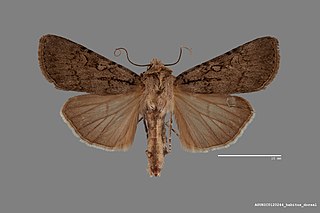
Euxoa choris is a moth of the family Noctuidae first described by Leon F. Harvey in 1876. It is found in North America from south-western Saskatchewan, central Alberta and south-central Yukon, south to New Mexico, Arizona and California.

Archips negundana, the larger boxelder leafroller, is a moth of the family Tortricidae. The species was first described by Harrison Gray Dyar Jr. in 1902. It is found in North America from southern British Columbia to southern Quebec, south to California and Florida.
Semioscopis aurorella, the aurora flatbody moth, is a species of moth of the family Depressariidae. It was described by Harrison Gray Dyar Jr. in 1902. It is found in Canada from north-central Alberta to south-eastern Ontario, south into the United States between south-central New York and Wisconsin.
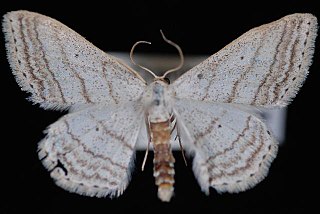
Scopula ancellata, the angled wave moth or pointed-winged wave, is a moth of the family Geometridae. It was described by George Duryea Hulst in 1887. It is found in North America from Quebec west to the Northwest Territories and British Columbia and south to Michigan, Indiana and Arizona. The habitat consists of mixed wood and coniferous forests.















